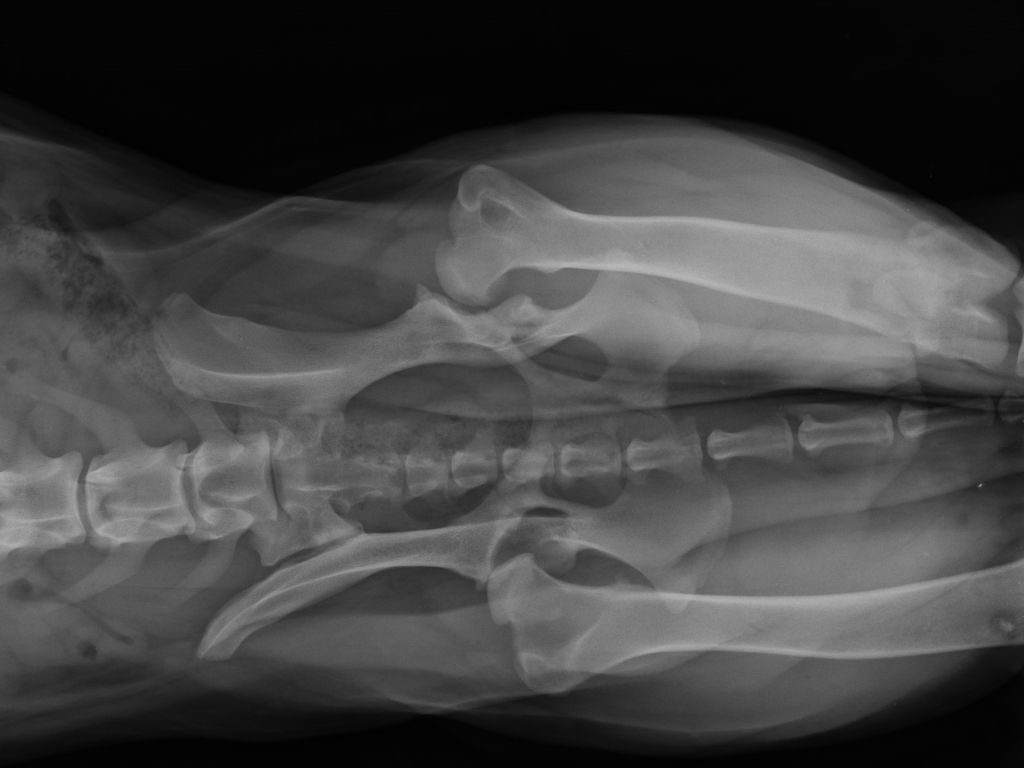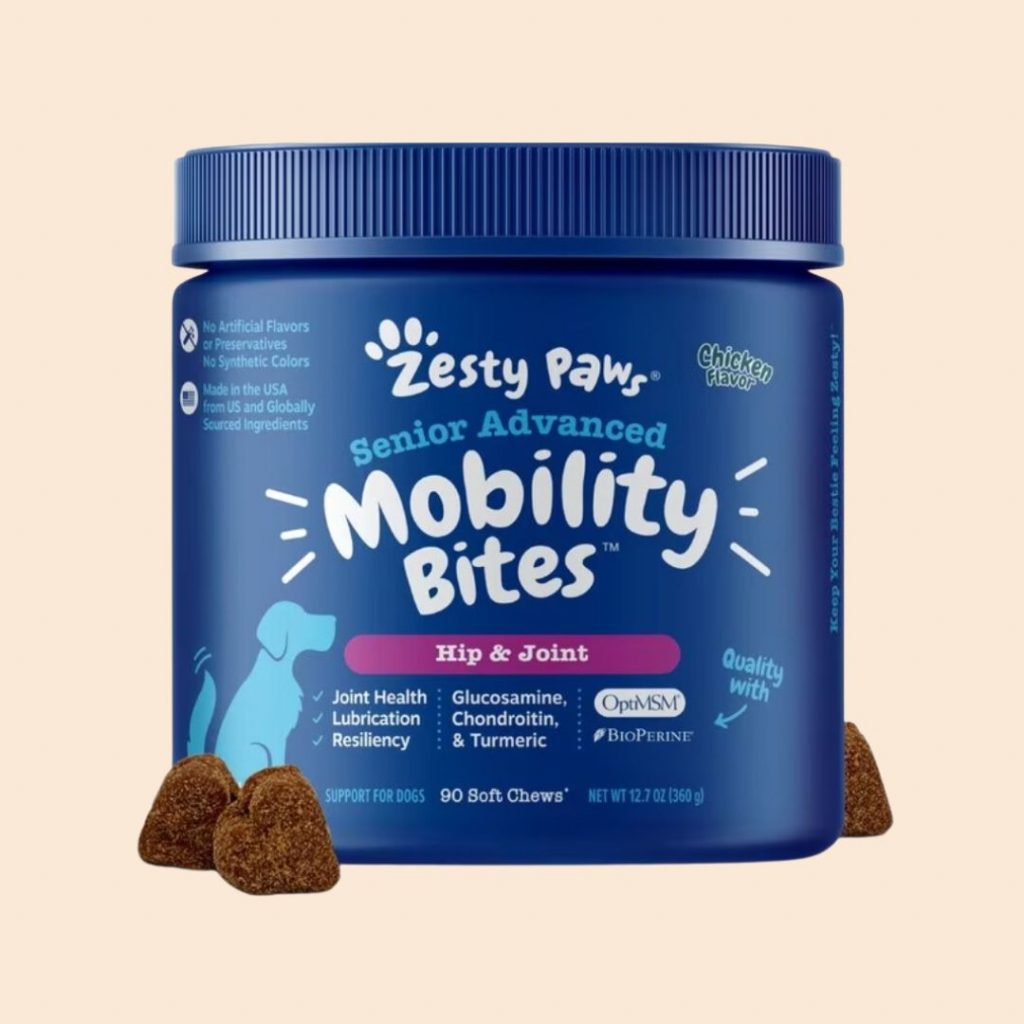
Arthritis is a common condition that affects dogs as they age, but it’s not exclusively for senior pets. It can cause pain, stiffness, and reduced mobility, making it difficult for senior dogs to enjoy their daily activities.
There are several ways you can help your furry companion manage and alleviate the symptoms of arthritis. We will explore various strategies and techniques to support your senior dog’s well-being and enhance their quality of life.
Understanding Arthritis in Dogs
Arthritis, also known as osteoarthritis, is a degenerative joint disease that affects the joints and surrounding tissues. It causes inflammation, pain, and stiffness in the joints, significantly impacting a dog’s mobility and overall well-being when left untreated.
🐶FUR FACT: The word arthritis comes from the Greek word “Arthro” that means joint, and “-itis” that means inflammation.
Signs of Arthritis
- Reluctance to move.
- Difficulty rising or lying down.
- Limping.
- Stiffness, especially after rest.
- Reduced activity levels.
- Back legs shaking.
- Lick repeatedly at the joint.
- Other changes in behavior, like snapping if you attempt to touch them.
What Causes Arthritis?
A healthy joint is designed to promote smooth pain-free motion. The bones fit smoothly together, the smooth cartilage coats the ends of the bones allowing movement without resistance, and the joint capsule contains slippery joint fluid to keep the joints moving smoothly.
This perfect design can spoil due to wear and tear, genetics, or injuries. Let’s see some examples:
- Damage in the ligaments will make the joints become unstable.
- Inflammation in cartilage makes the lining painful and increases the risk of further damage.
- Joint fluids become less slippery as part of the aging process.
- Inherited genes for badly shaped joints cause extra friction and inflammation.
Veterinary Guidance and Treatment Options
A veterinarian is your best resource when it comes to managing your senior dog’s arthritis. Schedule a visit to discuss your dog’s condition, medical history, and any specific concerns you may have. The vet will perform a thorough examination, which may include X-rays or blood tests, to assess the extent of arthritis and recommend appropriate treatment options.

The treatment for arthritis includes weight management, physical therapy, lifestyle modifications, joint supplements, and medications. The prognosis is typically good, with the proper care your dog will able to enjoy his/her regular activities.
We will explore in detail the treatment plan in the next sections.
Appropriate Diet and Weight Management
The excess weight can put additional strain on their joints. Moreover, the fat in obese dogs secretes inflammatory hormones that contribute to inflammation and pain.
The goal is to promote a lean body, which means a well-defined waistline visible when you see your dog from above.
Work with your veterinarian to achieve this, and determine the appropriate diet for your senior dog. They may recommend a balanced, low-calorie diet, and rich in omega-3 fatty acids. Feeding your dog smaller, more frequent meals can also help manage their weight and digestion.
You may also want to include anti-inflammatory foods in their diet such as turmeric, green vegetables, blueberries, bone broth, salmon, sardines, and mackerel, to mention some.
To learn more about proper nutrition for healthy aging we recommend checking our guide: Optimal Senior Dog Food: Nutrition for Healthy Aging
Regular Exercise and Physical Therapy
While it’s vital to ensure that your senior dog gets enough rest, regular exercise and physical therapy play a vital role in managing arthritis.
Low-impact exercises, hydrotherapy, massages, and controlled movements can help maintain joint flexibility and strengthen the muscles around the affected joints.
Let’s review each of these treatments and their main benefits:
Hydrotherapy
Hydrotherapy is great because it gives the opportunity to improve movement without putting strain on sore joints. This therapy consists of putting your dog in a heated pool with a supportive harness. The benefits include:
- Increase range of motion.
- Muscle strengthening.
- Pain relieves, and improves swelling and stiffness.
- Promote tissue healing.
- Improve circulation.
- Promote recovery.
Physiotherapy
This includes a routine of exercises to strengthen the muscles designed by a qualified pet physiotherapist. Besides the physical benefits, this therapy promotes mental stimulation and activities to bond with your pet.
Massages
Massages promote blood circulation, improve flexibility, strengthen muscles, and help your pet relax. To give your pet a massage, first start by placing your whole hand in contact with your pet and apply gentle and firm pressure. Glide over your pet’s fur, following the direction of the fur.
Passive Movement
After warming up your dog’s muscles and joints with a massage, you can focus on passive movements. To perform this therapy, your pet should be laying down and you will gentle bend and extend each leg at a time. It’s important not to put any twisting or rotating forces on the joint, just follow the regular movement.
👆🏼Important: Your veterinarian or a professional animal physiotherapist will help you develop a suitable exercise and physical therapy plan for your senior dog.
Non-Medical Interventions
There are alternative therapies such as acupuncture, laser therapy, tens, heat and cold, and acupuncture that can help alleviate arthritis symptoms. These non-invasive treatments can relieve pain, reduce inflammation, and improve mobility.
- LASER therapy increases local blood supply and triggers the release of natural endorphins.
- Acupuncture works by triggering natural endorphins and opiate release. It can be a great option for patients who tolerate needles.
- TENS is used to numb pain by passing a weak electrical current between trigger points. A physiotherapist can teach a pet parent how to use this therapy at home, but the benefits tend to be short-lived and wear off soon after the current is switched off.
- Heat and cold therapy can also provide relief to arthritic joints. Apply a warm compress or use a heating pad set on low to help soothe stiff joints and relax muscles. Similarly, cold therapy with ice packs or cold compresses can help reduce inflammation and swelling.
👆🏼Important: Always consult with your veterinarian before using any therapy to ensure the safety and effectiveness of these methods.
Adapting their Environment
Ensure that they have a soft, orthopedic bed or supportive bedding material that cushions their joints. Place their bed in a warm and draft-free area of your home, away from cold and damp surfaces.
Consider using mobility aids such as ramps or stairs to minimize the need for your dog to jump onto furniture or climb stairs.
Other mobility aids include harnesses and slings, boots, strollers, and wheelchairs to help them when walking. Elevated food stations help them when eating because they release the extra weight in the front legs.
You should also adapt your flooring, using mats, runner carpets, or any other anti-slippery materials to prevent falls and injuries. Check more ideas here: 8 Creative Solutions to Stop Your Dog from Slipping on Floors

Using Joint Supplements and Medications
Your veterinarian may recommend specific supplements such as glucosamine and chondroitin, which can promote joint health and reduce inflammation. These two are typically given together because they amplify the effect of the other.
Glucosamine’s benefits are:
- Provides the building blocks for hyaluronic acid, which is what makes joint fluid slippery.
- Improves the lubrication of the joints.
- Mild anti-inflammatory effect.
- Encourages cartilage to produce a slippery, protective layer, which protects the joint.
Chondroitin’s benefits are:
- Inhibits natural chemicals within the joint that damage the cartilage lining.
- Helps soothe inflamed cartilage.

You may also want to refer to our ranking of Best Joint Supplements for Senior Dogs.
In some cases, prescription medications such as nonsteroidal anti-inflammatory drugs (NSAIDs) or pain relievers may be necessary. These work by blocking the production of certain chemicals which trigger pain and relieve the actual pain itself. However, this medication should be used with respect and following your vet’s instructions. The biggest complication is stomach ulcers, but, when given with or after food this risk is greatly reduced.
Follow your veterinarian’s advice regarding the appropriate dosage and administration of these supplements and medications.
Monitoring and Adapting the Treatment Plan
Arthritis is a progressive condition, and your senior dog’s needs may change over time. Therefore, regular monitoring and communication with your veterinarian are essential to assess the effectiveness of the treatment plan and make necessary adjustments.
Keep track of your dog’s mobility, pain levels, and overall behavior to provide accurate information to your veterinarian during follow-up visits.
Conclusion
The goal of arthritis management is to help alleviate your dog’s pain, enhance mobility, and improve their quality of life. So, in order to help your senior dog with arthritis you should implement a comprehensive approach that includes veterinary guidance, lifestyle adjustments, and a focus on their overall well-being. Consider exploring different treatment options and finding what works best for your furry companion.
FAQs
No, consult with your veterinarian before administering any pain relievers to your dog. Over-the-counter medications meant for humans can be toxic to dogs and may have adverse effects. Your veterinarian can prescribe safe and effective pain medications specifically tailored to your dog’s condition.
High-impact exercises or activities that put excessive strain on the joints should be avoided for dogs with arthritis. These may include activities like jumping, running on hard surfaces, or intense agility training. Gentle, low-impact exercises and controlled movements are generally more suitable.
Yes, weight loss can have a significant impact on a dog with arthritis. Excess weight puts additional stress on the joints, worsening the symptoms and discomfort. A healthy weight can reduce the burden on the joints and improve mobility.
Certain natural remedies, such as herbal supplements or dietary changes, may provide some relief for dogs with arthritis. However, it’s important to consult with your veterinarian before introducing any natural remedies, as they can interact with medications or have varying effectiveness based on individual cases.
Related Articles
- How to Bathe a Senior Dog: Tips for a Comfortable Experience
- Why My Old Dog Won’t Eat from the Bowl Anymore
- Senior Dog 101: Our Curated Care Guide for Senior Dogs
- How to Make Homemade Food for Senior Dogs
Recent Posts
Amazon's Top Black Friday and Cyber Monday Deals for 2024: Dog Products Edition
The holiday shopping season has officially started and Amazon has already released some incredible deals on pet products for Black Friday and Cyber Monday 2024. Here is our curated list of the...
As someone who boards dogs as a side gig, I am used to seeing many pet trackers and smart collars these days. These devices have become a must-have tool for pet owners (especially when trusting their...
